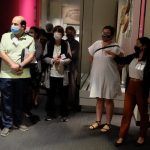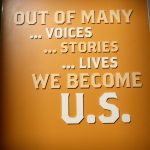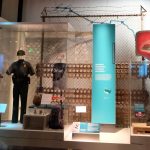By Professor Tiffany Banks On Tuesday, September 30th , students from my COMM 108: Foundations…

April 13 found the Fellows back at the National Museum of American History (NMAH), this time to explore and learn about one of their stellar exhibits, Many Voice, One Nation. Following introductions and lunch, the afternoon got underway with Margaret Salazar-Porzio, Curator of Latinx History and Culture, NMAH who spoke about what she sees as the important work of museums as institutions of culture. Curators, exhibit developers and education staff are guided by knowing that visitors want to see themselves as they walk through exhibits and participate in the public programming the museums offer. The exhibits need to have those places of connection while also engaging in ways that prompt deeper thinking, challenge assumptions and provide new perspectives. She also spoke about the practical realities of raising funds to mount exhibits, especially for those that include controversial topics. Striking a balance between satisfying a variety of stakeholders while also conveying information in an accurate manner is an on-going challenge.
Using the Many Voices, One Nation exhibit as an example, Fellows learned of the challenges of putting together a permanent exhibit, one with a minimum lifespan of 20-25 years. How are certain objects and events viewed today? By what audience? How will they be viewed by those same people in five years? Ten years? How do you make the new exhibit fit with existing objects on display? This exhibit is in the Hall of the People, dominated by the larger than life, classically styled sculpture of George Washington. This statue depicts Washington as a leader and victorious general who rather than assume a throne chose to hand power over to the people. By positioning the Democracy exhibit to one side of the Hall and the Many Voices, One Nation exhibit to the other, a visitor is given a powerful message upon entering this wing of the museum.

On entering the Many Voices, One Nation exhibit, the visitor immediately sees images of the rich diversity of people who have and continue to make up our country. Fellows were reminded that our country was settled with four broad groups: those who were already here, those who came willingly, those who were forced and those who were suddenly “here” as borders changed. This began the “unsettling of the continent” which is documented in the first section of this exhibit.

The influence of all of these groups is present throughout the various sections of the exhibit as the visitor is asked to consider three questions: Who is Free? Who is Included? Who is Equal? The second section focuses on “peopling the expanding nation” as diverse groups sought to establish their place and be included and incorporated into developing country.. Prominent display cases focus on Places of Negotiation and highlight those areas where people have sought to be included and to have their voices heard. Other areas display ways in which communities have been created and expanded, while still another reminds of us continuing struggles and debates.

Throughout the tour, Fellows had the opportunities to ask questions about the objects on display, the thinking behind how the displays were organized and were also able to see current visitors interacting with the various portions of the exhibit. Fellows also were given time to explore on their own before returning to the Conference room for the second of the afternoon’s presentations.

Upon returning to in the Johnson Center, Magdalena Mieri, Director, Program in Latino History and Culture, shared the rich teacher resources the museum staff has developed as a companion to the Many Voices, One Nation exhibit. Titled, “Becoming Us”, this set of resources provides a framework for helping students of all ages develop essential understandings about the history of migration and immigration in the United States. Lessons are arranged thematically and focus on Borderlands, Education, Policy, Resistance and Belonging. Within each area, there are case studies both historical and contemporary, which help illustrate key concepts, questions for deliberation and ideas to further engage students. Through her presentation, Fellows gained an appreciation of the time, effort and care that went into developing a curriculum that aims to be accurate, inclusive and respectful.
Once again, it was a wonderful afternoon, filled with new information and ideas for all.





This Post Has 0 Comments